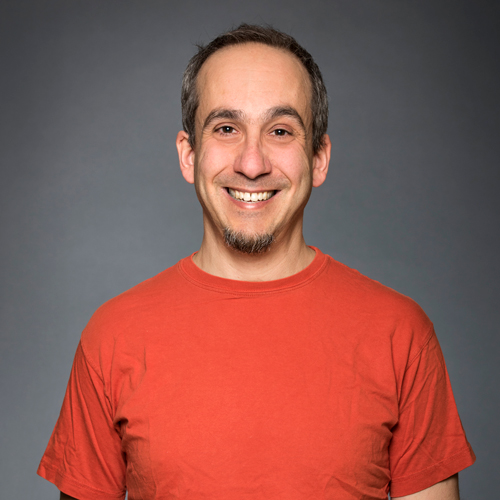Biography
Research Program
Work in the Rudner lab is focused on understanding fundamental problems of chromosome dynamics. Defects in chromosome structure and segregation can lead to chromosome loss and damage, both critical events in the development of cancer and chromosomal disorders. We use the budding yeast, Saccharomyces cerevisae, as a model for understanding the assembly and regulation of chromosomes. Budding yeast is an excellent model system because most cell biology is well conserved between yeast and humans, and yeast provides a facile genetic system in which hypotheses can be rapidly and rigorously tested.
Chromosome Segregation
Our work studying chromosome segregation is focused on understanding how cells know when to initiate anaphase. At anaphase onset, replicated sister chromatids segregate into two daughter cells. Errors in this highly orchestrated event can cause loss, gain and damage to chromosomes. Changes in chromosome content (also called aneuploidy) are very problematic for cells and are found in almost all cancers. Anaphase onset requires the activity of Cdk1 (Cyclin-dependent kinase) a highly conserved protein kinase, and our work has focused on 1) how upstream regulators of Cdk1 regulate anaphase initiation, 2) elucidating the critical targets of Cdk1 that trigger anaphase and 3) understanding how protein phosphatase 2A (PP2A) counteracts Cdk1 activity. Understanding the fundamental mechanisms of how cells trigger anaphase will help lead to therapeutics that improve the fidelity of chromosome segregation as well as new anti-mitotic chemotherapeutics.
Chromosome Structure
We are also interested in understanding how particular chromosomal domains assemble, specifically heterochromatin. Heterochromatin, or silent chromatin, which constitutes up to half of the vertebrate genome, is remarkably dynamic: it is epigenetically inherited and its boundaries and locations change as cells divide and differentiate. Budding yeast heterochromatin is assembled from the Sir2, Sir3 and Sir4 proteins bound to nucleosomal DNA. We are focused on understanding how heterochromatin is regulated during the cell cycle, distinguishing the role of the Sir proteins in nucleation and spreading of heterochromatin, determining the structural basis of heterochromatin spreading and understanding what aspects of Sir-dependent silencing is conserved in vertebrates.
Using Yeast to Understanding a Rare Genetic Disease
A recent project in the laboratory is the result of a fruitful collaboration between our lab and Pranesh Chakraborty at the Children’s Hospital of Eastern Ontario (CHEO). Pranesh and his collaborators identified a cohort of children with SIFD (sideroblastic anemia with B cell immunodeficiency, periodic fevers and developmental delay), a new congenital disorder that resembles inherited mitochondrial diseases. Whole exome sequencing of these patients has shown that a highly conserved translation factor is mutated in these patients. We have developed a yeast model of SIFD to examine how mutations in this gene cause disease.
Recent Publications
- Bentley-DeSousa, A., Holinier, C., Moteshareie, H., Tseng, Y-C., Kajjo, S., Nwosu, C., Amodeo, G.F., Bondy-Chorney. E., Sai, Y., Rudner, A., Golshani, A., Davey, N. and Downey. M.. 2018. A screen for candidate targets of lysine polyphosphorylation uncovers new links to ribosome biogenesis. Cell Reports, 22 (13). PMID 29590613
- Lianga, N., Doré, C., Kennedy, E.K., Yeh, E., Williams, E.C., Fortinez, C.M., Wang, A., Bloom, K.S., Rudner, A.D. 2018. Cdk1 phosphorylation of Esp1/Separase functions with PP2A and Slk19 to regulate pericentric Cohesin and anaphase onset. PLoS Genetics, 14 (3). PMID 29561844
- Samel, A., Rudner A.D., Ehrenhofer-Murray, A.E. 2017. Variants of the Sir4 Coiled-Coil Domain Improve Binding to Sir3 for Heterochromatin Formation in Saccharomyces cerevisiae. G3, 7 (4). PMID 28188183
- Albert, B., Knight, B., Merwin, J., Martin, V., Ottoz, D., Bruzzone, M.J., Rudner, A.D., Gerber, S.A., Gygi, S.P., Moazed, D., Shore, D. 2016. A molecular titration system coordinates ribosomal protein gene transcription with ribosomal RNA synthesis. Molecular Cell, 64.
- Roney, I., Rudner, A.D., Couture, J-F., Kaern, M. 2016 Improvement of the reverse tetracycline transactivator by single amino acid substitutions that reduce leaky target gene expression to undetectable levels. Scientific Reports, 6
- Kennedy, E.K., Dysart, M., Lianga, N., Williams, E.C., Pilon, S., Doré, C., Deneault, J-S., Rudner, A.D. 2016. Redundant regulation of Cdk1 tyrosine dephosphorylation in Saccharomyces cerevisae. Genetics, 202 (3). PMID 26715668.
- Larin, M., Harding, K., Williams, E.C, Lianga, N., Doré, C., Pilon, S., Langis, E.,Yanofsky, C., Rudner, A.D. 2015. Competition between heterochromatic loci and the abundance of Sir4 regulates de novo assembly of silent chromatin. PLoS Genetics, 11 (11). PMID 26587833.
- Szeto, S., Williams, E.C., Rudner, A.D., Lee, J.M. 2015. Phosphorylation of filamin A by Cdk1 regulates filamin A localization and daughter cell separation. Experimental cell research, 330, 248-66 (CN=2). PMID 25445790.
- Chakraborty, P., Kyriacos, M., Kennedy, E.K., Durie, D., Mamady, M., Nass, T., (21 other authors), Rudner, A.D., Holcik, M., Fleming, M. 2014. Mutations in TRNT1 cause congenital sideroblastic anemia with immunodeficiency, fevers and developmental delay (SFID). Blood, 124, 2867-71. PMID 25193871
- Delgoshaie, N., Tang, X., Kanshin, E.D., Williams, E.C., Rudner, A.D., Thibault, P., Tyers, M., Verreault, A. 2014. Regulation of the Saccharomyces cerevisiae histone deacetylase Hst3 by Cdk1 and SCFCdc4. Journal of biological chemistry, 289, 13186-13196. PMID 24648511
- Lianga, N., Williams, E.C., Kennedy, E.K., Doré, C. Pilon, S., Girard, S.L., Deneault, J.S. and Rudner, A.D. 2013. A Wee1 checkpoint inhibits anaphase onset. Journal of Cell Biology, 201, 843–862. PMID 23751495
